South Florida Native Plants

Exploring Florida’s Native Plants
Here are some examples of plants native to South Florida. These native species would be great additions to any native garden or landscape in our region. Florida native plants are available for sale locally via Fairchild’s online plant sales. Members of the garden’s Native Plant Network are eligible to pick up a free ‘Starter Kit’ of five native plants for their home gardens.
Shrubs Native to Florida
Blackbead
Pithecellobium keyense
Pithecellobium keyense, known as blackbead, is native to coastal habitats of south Florida and tropical America. It is a much-branched shrub with fragrant white to pale pink flowers. The interesting coiled pods split open to reveal black seeds with a red aril. Blackbead is a larval host plant for the large orange sulphur and also for the cassius blue butterflies.
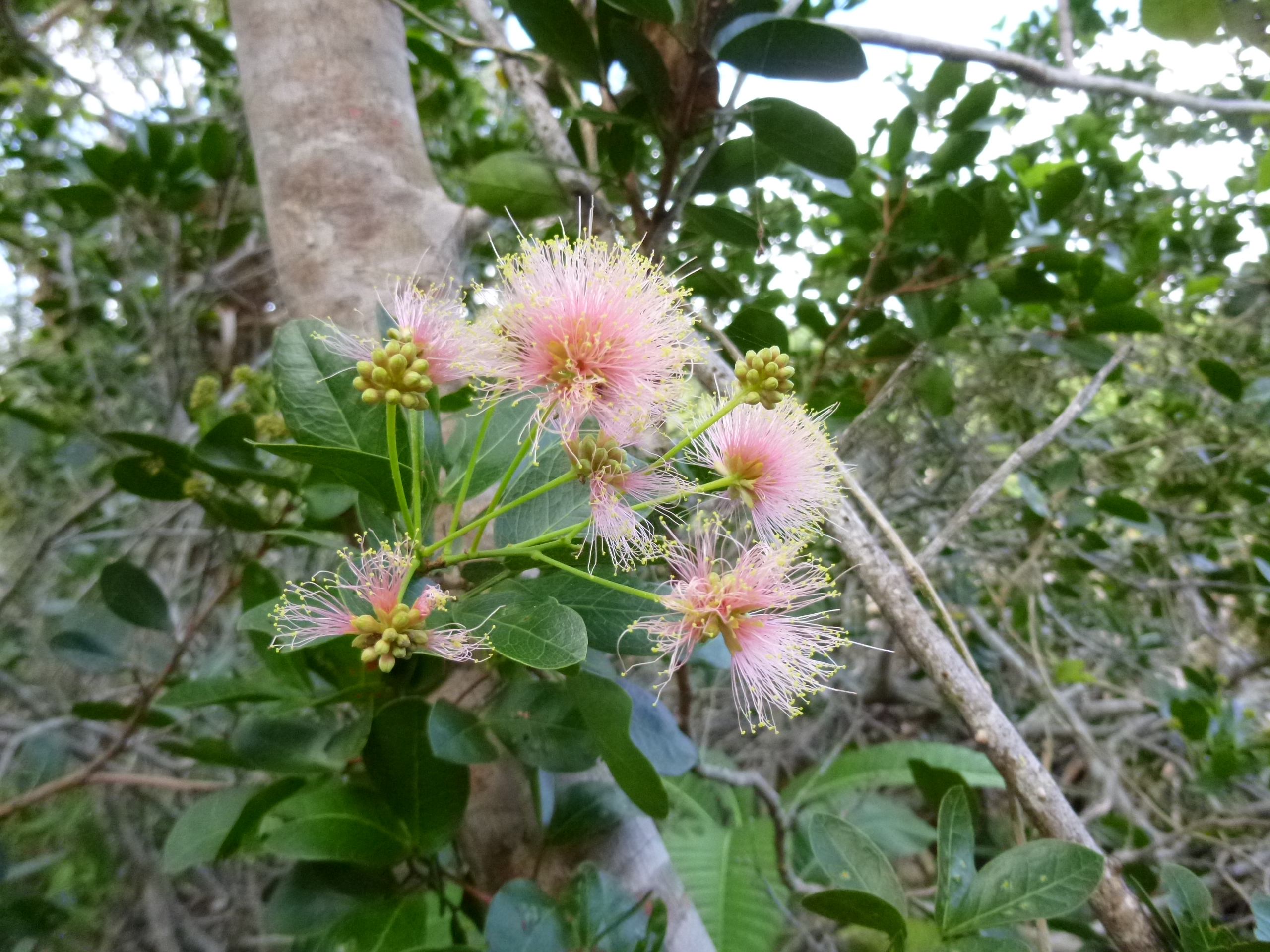
Nectar visitors include cassius blue, Florida duskywing, Florida white, giant swallowtail, great southern white, hammock skipper, large orange sulphur, mangrove skipper, Miami blue, three-spotted skipper, twin-spot skipper and other butterflies.
According to Roger Hammer, the seeds are consumed by native and exotic doves along with white-crowned pigeons and northern mockingbirds. This native species is a wonderful addition to the landscape to attract butterflies and birds.
Beautyberry
Callicarpa americana
Callicarpa americana, beautyberry, is one of our most beautiful native shrubs. Beautyberry is a fast growing shrub to 6 feet tall. Clusters of pink flowers encircling the stems at the leaf axils are produced in the summer followed by vibrant clusters of bright purple fruits which remain on the plant for several months. Beautyberry attracts wildlife, particularly birds, to eat the fruit and the flowers attract bees.
This native shrub looks best if it is cut back during May or June to encourage new growth. Beautyberry may be grown in full sun to light shade and is found in south, north, and central Florida.
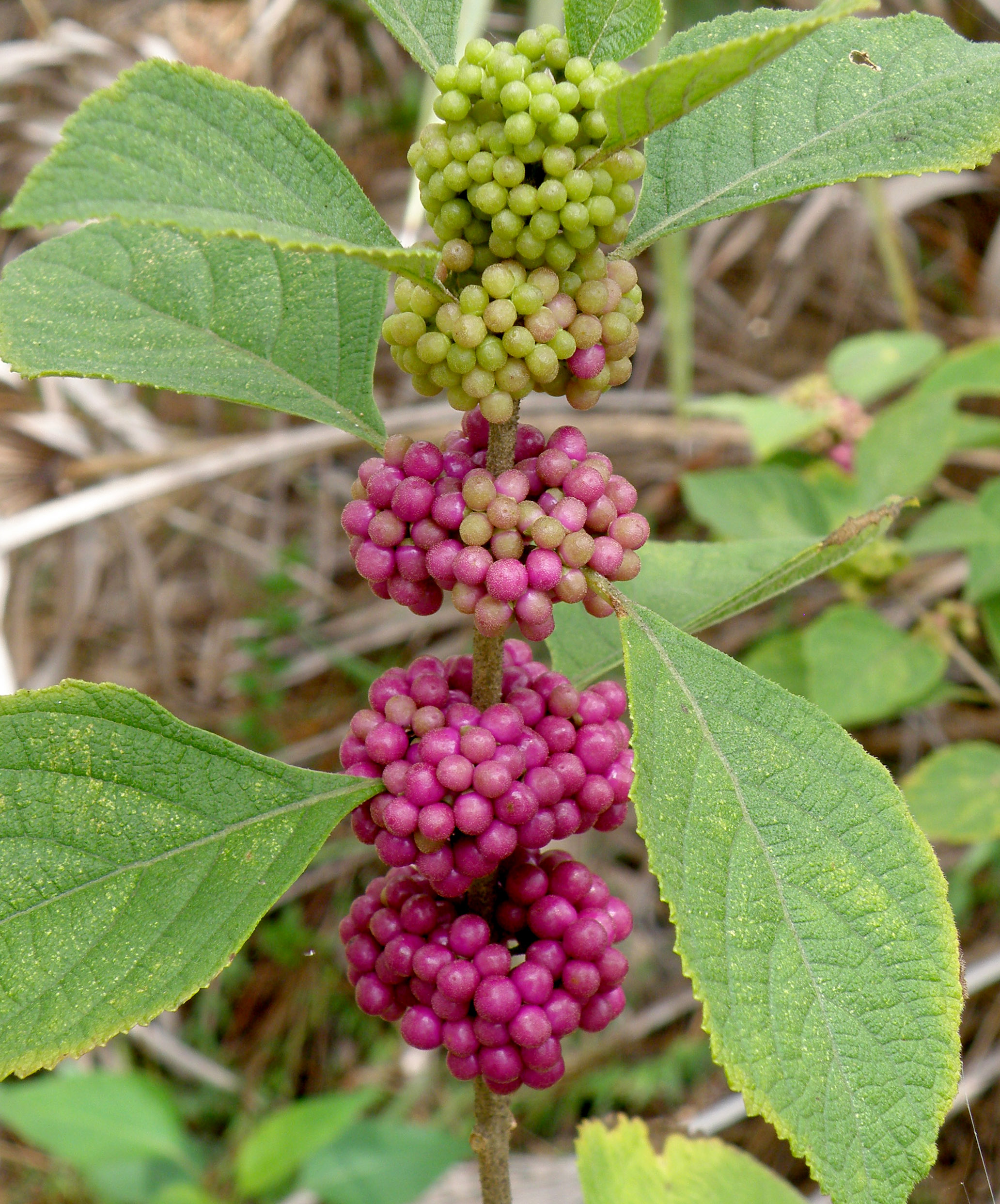
Pineland Croton
Croton linearis
Croton linearis, a native of South Florida pine rocklands, is commonly known as pineland croton. This 2’ to 6’ tall semi-woody shrub has dark green linear leaves with white or golden hairs on their lower surface. Small white flowers are present all year. This native species is dioecious; female plants produce small dry capsules which pop open when ripe. Pineland croton is the larval food plant for the Bartram’s Hairstreak and the Florida Leafwing butterflies, both of which are federally endangered. This shrub grows best in a sunny, dry location. Once established, these native plants require no supplemental irrigation.
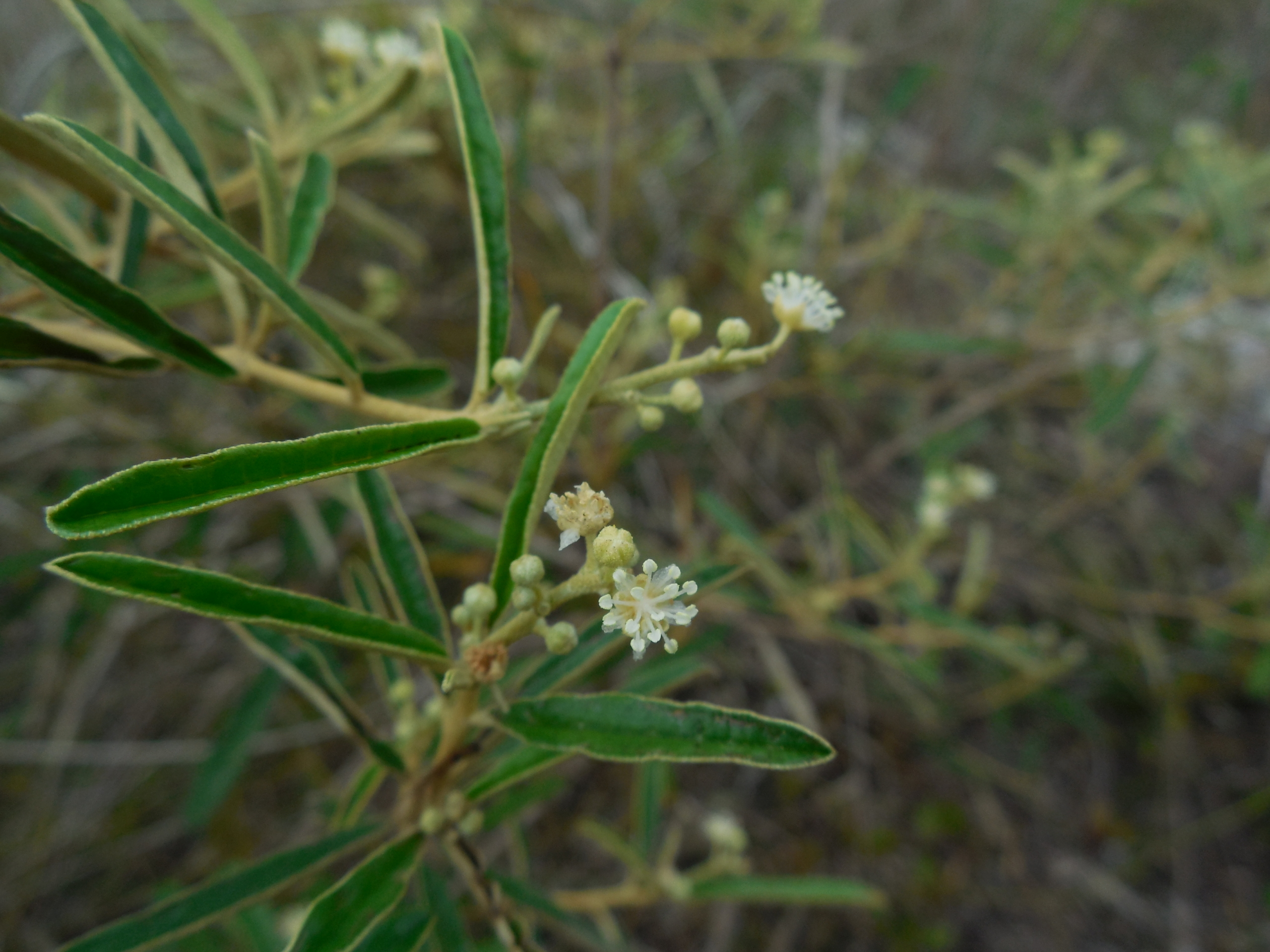
Bahama Senna
Senna mexicana var. chapmanii
Senna mexicana var. chapmanii, known as Bahama senna, is a flowering plant native to South Florida, the Bahamas and Cuba. It is a small shrub to 6 feet tall with yellow flowers nearly all year. Bahama senna is a larval host plant for several butterflies, including the orange-barred sulphur, sleepy orange sulphur, and cloudless sulphur. It grows best in full sun. Bahama senna is a wonderful choice for all butterfly gardens.
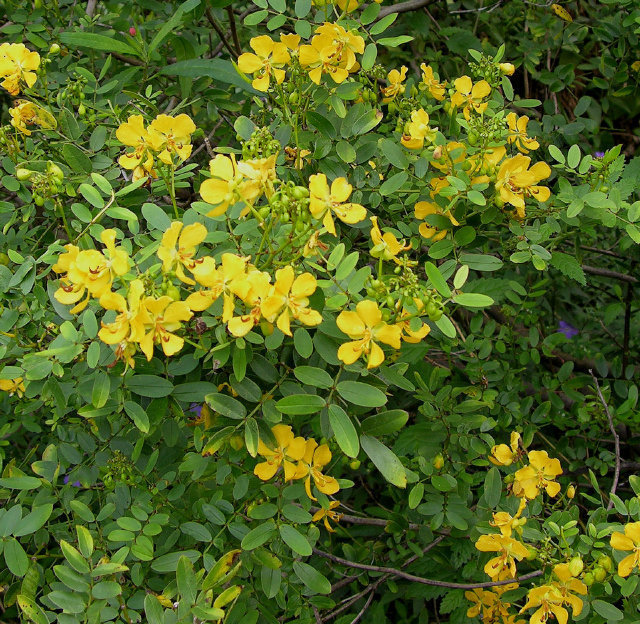
Coontie
Zamia integrifolia
Zamia integrifolia, coontie, is our only native cycad. Once locally abundant, this Florida native plant is now uncommon and threatened by urban development. The stems, after suitable treatment, were used as a source of starch by the Seminole Indians; a starch extraction industry was established in South Florida in the 1850s. Coontie is a small cycad, with much-branched, underground stems. The leaves are a favorite larval food for the rare Atala butterfly. It grows in full sun to light shade. New growth appears each spring, although if cut back, new leaves may be generated at any time.
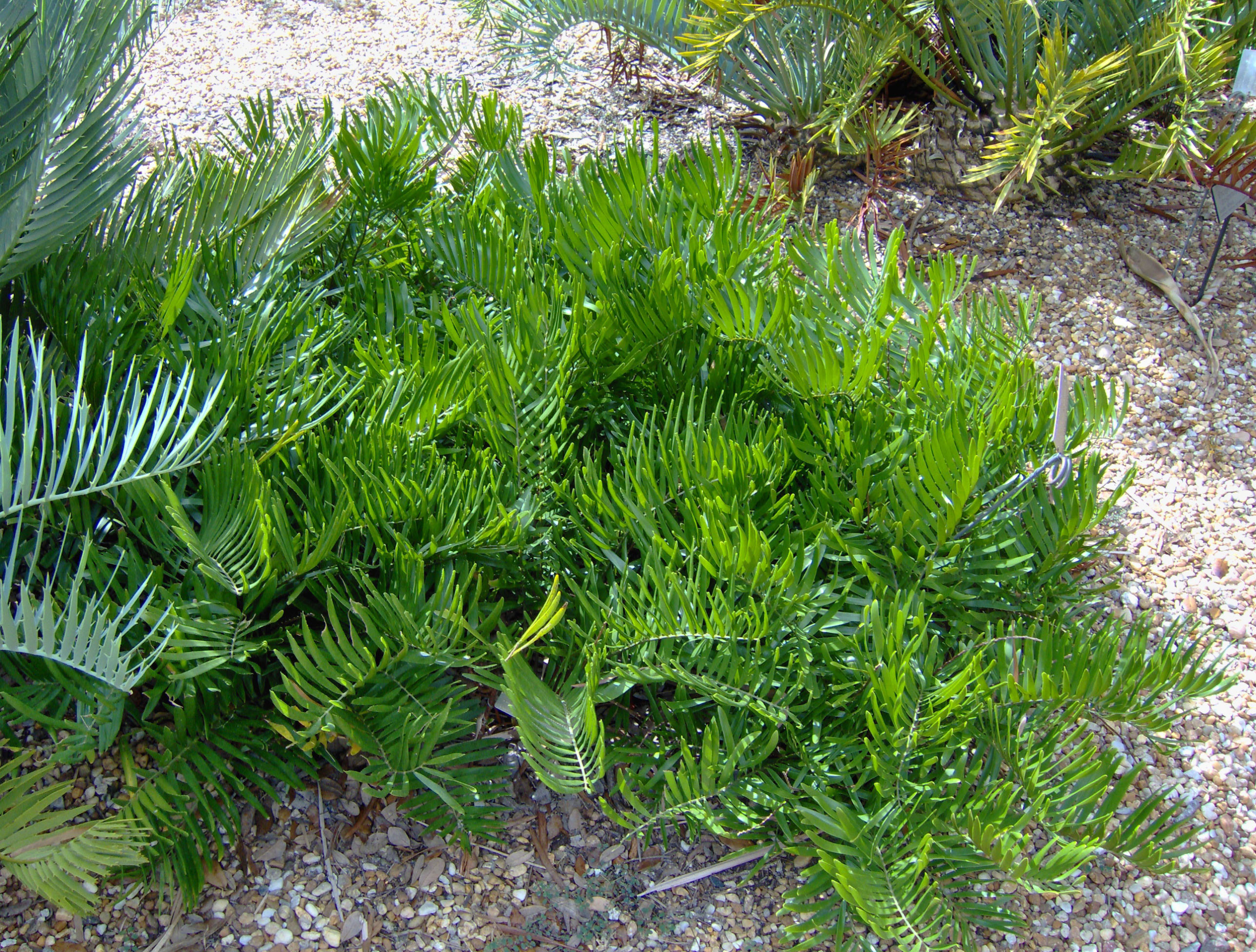
Wild Coffee
Psychotria nervosa
Psychotria nervosa, wild coffee, is an excellent small shrub that can be grown as a screen, a short hedge, or just to fill in a shady location. The glossy, bright green textured leaves, white flowers and vivid red fruits attract butterflies to sip the nectar of the flowers and birds to dine on the fruit of these native plants. Wild coffee may be grown in shade to full sun.
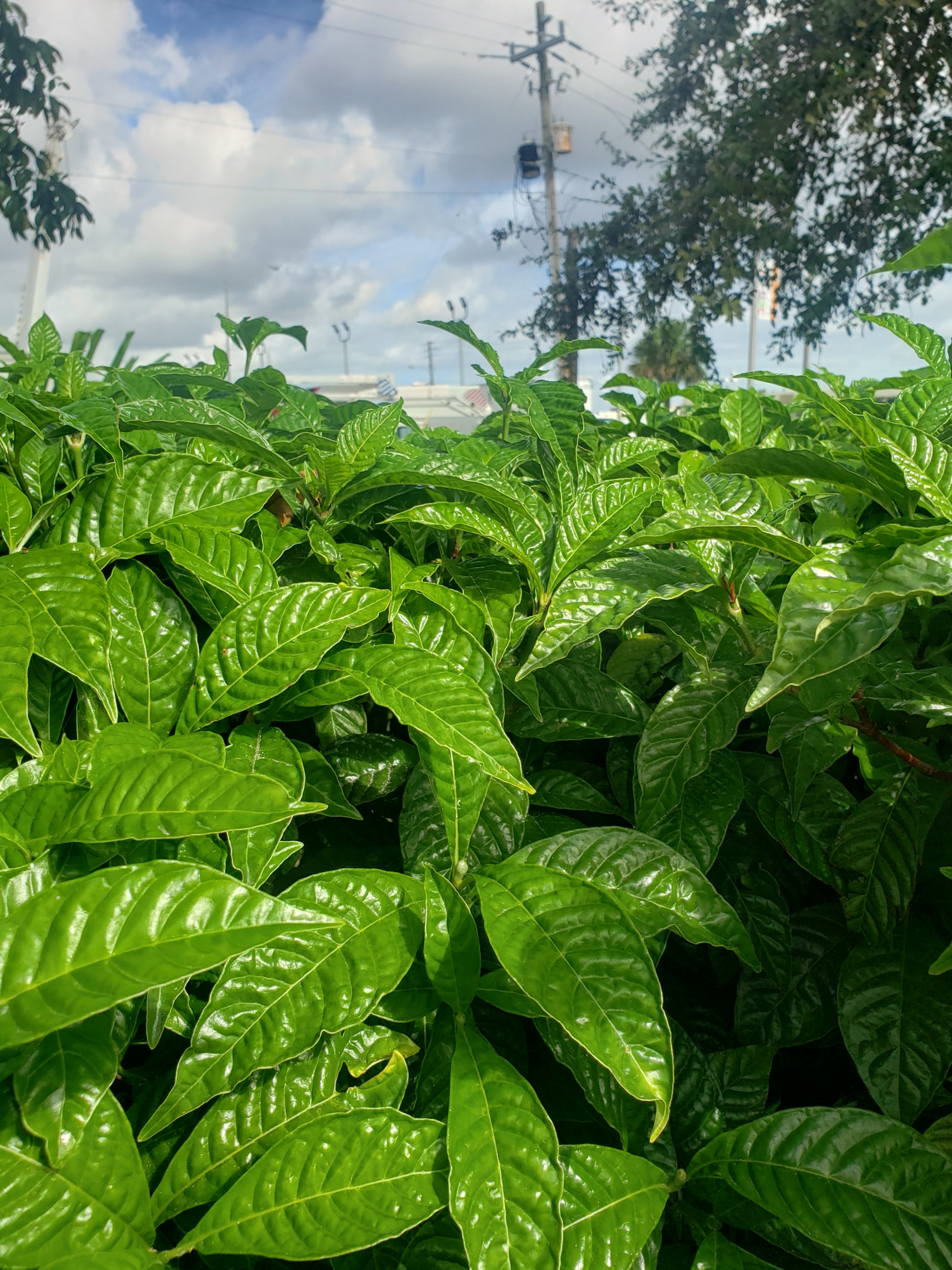
Fire Bush
Hamelia patens
Hamelia patens, known as fire bush, is one of the absolutely best native species for attracting wildlife to your garden. Flowers are loved by nectaring butterflies, thirsty hummingbirds, and other songbirds which eat the fruits. Do not purchase “dwarf,” “African” or other named varieties, as these are not native to South Florida. Plant a fire bush in your yard – our wildlife is depending on it!
West Indian Lilac
Tetrazygia bicolor
Tetrazygia bicolor, the West Indian lilac, is one of our most ornamental native shrubs. These beauties may be seen in pine rocklands or persisting in hammocks as a small tree. Distinctive leaves have three to five longitudinal ribs. Young leaves are pink. Butterflies visit the showy white flowers which are produced in large terminal racemes during the summer, followed by black fruits in the late fall. Butterflies visit the flowers. The fruits are much sought after by birds. It should be grown in full sun. These native plants are best grown in an area without supplemental irrigation. It does not tolerate pruning.

Bay Cedar
Suriana maritima
Suriana maritima, bay cedar, a fine-textured, spreading shrub, has gray- or yellow-green, downy leaves clustered at ends of the branches. Small yellow flowers usually appear nestled among the soft leaves during spring and early summer. It grows near the shore, where high winds, shifting sands, and salt spray sculpt it into interesting shapes. Found in south and central Florida, it is not established in north Florida and beyond. Plant in a bright, sunny location.

Smooth Strongbark
Bourreria cassinifolia
Bourreria cassinifolia, smooth strongbark, is a Florida endangered species native to a few pinelands of south Florida and the Florida Keys. Strongbark is a shrub to 8 feet tall and about 6 feet wide.
The small leaves, small white flowers, and bright orange fruit of these native plants attract butterflies to the flowers and birds to the fruit. The fragrance of the flowers is a wonderful, fresh, light but oh so nice perfume. This shrub prefers a sunny location and does not require irrigation once established.
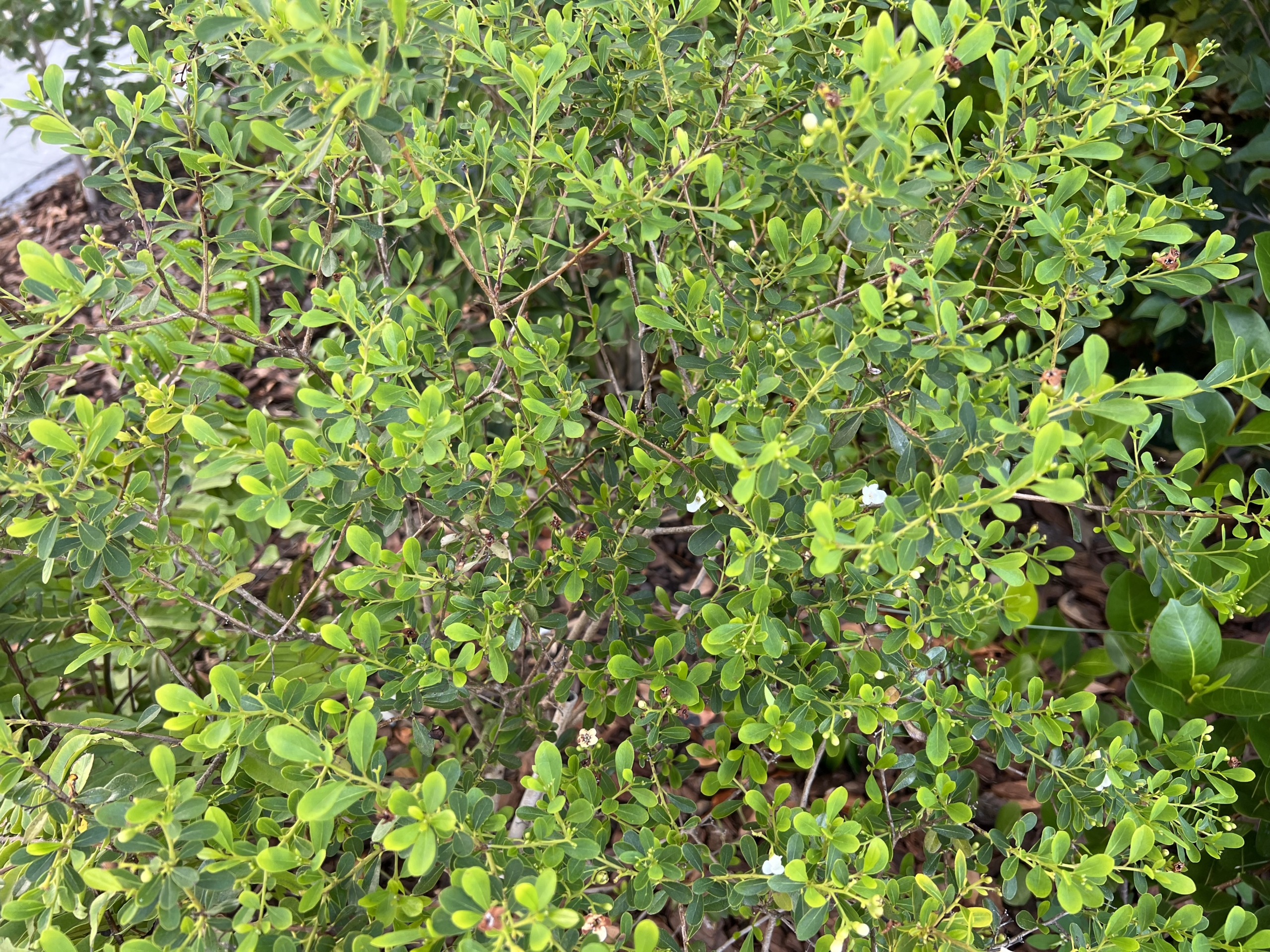
Shop the Fairchild Native Plant Nursery
Trees Native to Florida
White Stopper
Eugenia axillaris
Eugenia axillaris, known as white stopper, is a shrub to small tree growing to 20 feet tall. It is native to the coastal hammocks of South Florida, the West Indies and the Bahamas. It has small fragrant white flowers and aromatic leaves. The black fruits are enjoyed by birds. White stopper is very easy to grow in full sun to light shade. This is the native plant which imparts the commonly noted fragrance of our native hardwood hammock habitats. Go native! Plant a white stopper!
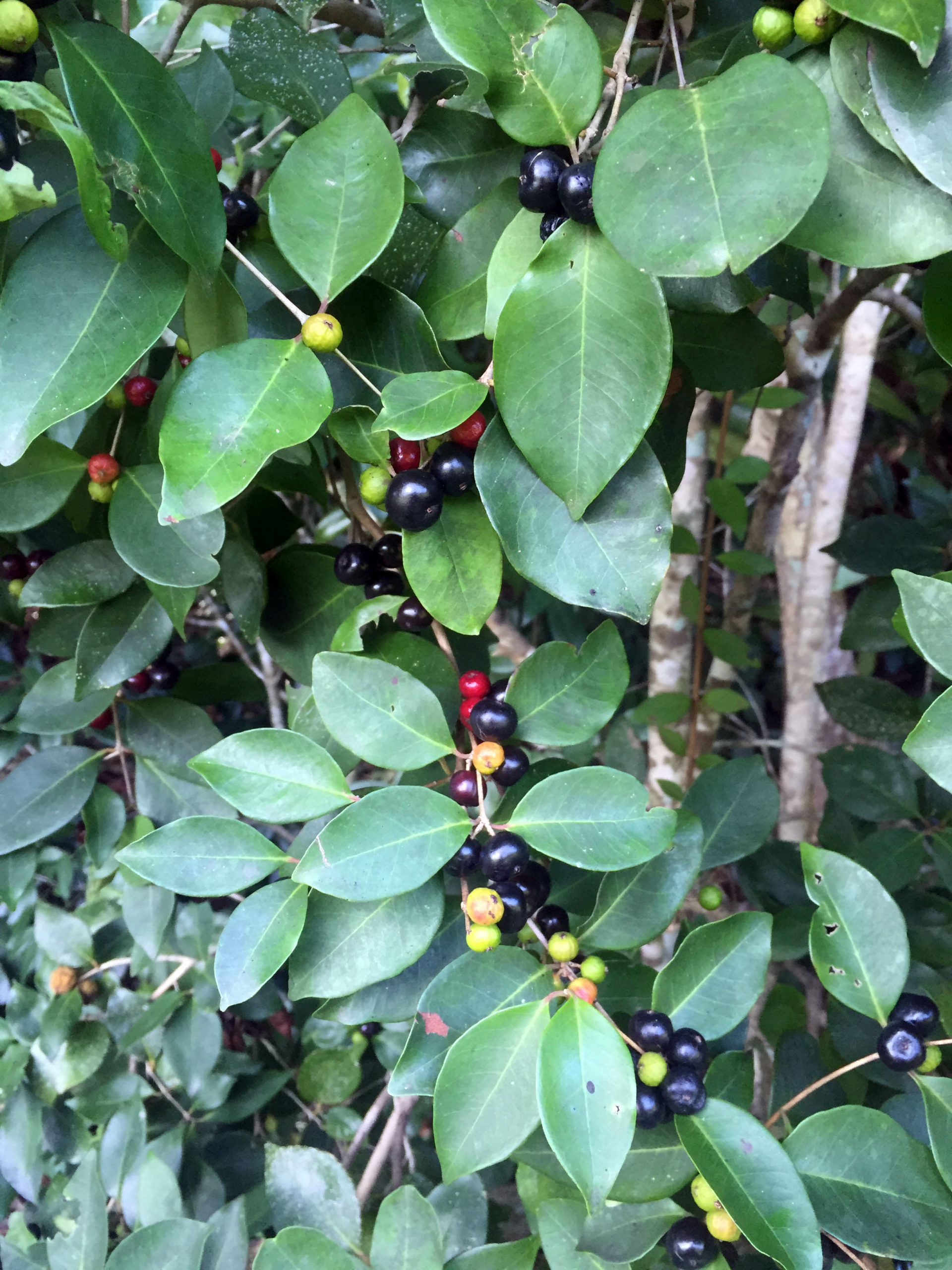
Mexican Alvaradoa
Alvaradoa amorphoides
Alvaradoa amorphoides, Mexican alvaradoa, is listed as endangered by the state of Florida. It is native to pine rocklands and hammock edges in the southern portion of Miami-Dade County and a few areas of Everglades National Park; the Bahamas, southern Mexico and Central America. Mexican alvaradoa has small pinnate leaves and slender branches imparting an open airy texture.
This is the host plant for the rare Dina Yellow (Eurema dina) butterfly in Florida. It is easily kept as a shrub with heavy spring pruning, or it may be allowed to grow into a slender tree to 20′ tall. It is a dioecious species with female plants producing small pendant clusters of reddish, winged seeds. Mexican alvaradoa is drought tolerant, shade tolerant and a great choice for butterfly enthusiasts.

Spanish Stopper
Eugenia foetida
Spanish stopper, Eugenia foetida, has a neat, upright growth habit, making it a perfect choice for a small area. During the summer, the stems of Spanish stopper are engulfed by fragrant, white flowers. After flowering, small red fruit turn black and are eaten by birds. All stoppers are easily maintained to the size desired. The lowest branches may be removed to give a more tree-like appearance. Stoppers have small leaves, are evergreen plants, and usually have a columnar shape, all characteristics which can fit into a small space.
These native plants will be denser if grown in full sun. When planted in a shady location, the stoppers will develop a more open growth habit with slightly larger leaves.
Lignum Vitae
Guaiacum sanctum
Guaiacum sanctum, lignum vitae, has gorgeous violet blue flowers amid dark green, glossy leaves that make it an outstanding choice for almost any garden. This rare Florida native also occurs in coastal forests of the West Indies, Mexico and Central America. It is a shrub to small tree, usually less than 12 feet tall, periodically graced at the same time with showy violet-blue flowers and ornamental yellow fruits which open to reveal five seeds, each covered in a vivid, red aril.
Lignum vitae grows successfully in a wide range of soil types and once established, is drought and salt tolerant. Regular irrigation and fertilizing will encourage new growth in this plant. Although it flowers best in full sun, it can flourish in partial shade. There are no significant insect pests or diseases associated with this species.
Simpson’s Stopper
Myrcianthes fragrans
Myrcianthes fragrans, Simpson’s stopper, is a native of hammocks of south Florida and Tropical America. This shrub or small tree grows to 20 feet tall. These native plants make a great hedge and are a low-maintenance alternative to the commonly used ficus hedge. Simpson’s stopper’s silvery gray to warm brown bark naturally peels to reveal a smooth burnished copper colored inner layer.
Fragrant little white flowers bloom intermittently through the spring and summer. Showy red-orange fruit provide food for several bird species. Simpson’s stopper will have a dense branching habit if grown in full sun, creating a wonderful, carefree hedge. To create a hedge or screen, these native plants should be planted about 3-4 feet apart.

Florida Fiddlewood
Citharexylum spinosum
Citharexylum spinosum is a fast-growing tree to 15 to 20 feet tall. In spring the bright green leaves turn an unusual salmon-orange color, and in cooler areas, about half the foliage falls. In tropical climates, fiddlewoods do not lose as many leaves. Creamy white sprays of fragrant flowers bloom at the branch tips from about midsummer to early winter. The fiddlewood is a lovely South Florida and West Indian native tree grown for its attractive foliage and fragrant flowers.
Both the genus name Citharexylum (from the Greek – kithara, lyre, and xylon, wood) and the common name of fiddlewood refer to the use of the tree’s timber to make sounding boards for musical instruments. Despite the scientific name, fiddlewood does not have spines.
Soldierwood
Colubrina elliptica
Colubrina elliptica, soldierwood, is native to the Florida Keys, the Caribbean, Mexico, Central America and Venezuela. It is a shrub to small tree, 10-30 feet tall with an open branching habit. The trunks have flaking orange to brown bark which adds to its character.
This plant is bird magnet! During the fall of 2009 expert birders surveyed Fairchild for migrating songbirds. Soldierwood in plot 164 attracted more species by far, than any other plant. Among the birds seen visiting soldierwood were: Tennessee warblers, Red-eyed vireos, Blue-winged warblers, Blackburnian warblers, Summer Tanager, Scarlet Tanager and Baltimore Orioles. Most of the birds were feeding on tiny insects that were attracted to the small flowers of soldierwood.
Black Ironwood
Krugiodendron ferreum
Krugiodendron ferreum, known as black ironwood, is an evergreen shrub to small tree with distinctive, dark green leaves with wavy margins. The glossy leaves glisten brightly in the sunlight. Small nectar-filled flowers are followed by black fruits much enjoyed by birds in the fall. Native to hammocks of South Florida, black ironwood has dense heartwood and an attractive compact, upright growth habit. It is also native to the West Indies, Mexico and Central America. Grow it in sun to partial shade.

Wild Cinnamon Bark
Canella winterana
Canella winterana, wild cinnamon bark, is native to South Florida, the Bahamas, and the West Indies. This small to medium-sized evergreen tree reaches 25′ tall, with a dense crown of glossy, dark green leaves. Clusters of small, dark red, fragrant flowers appear in spring through summer, followed by small, velvety red fruits, which ripen during winter and early spring. The dark red flowers and fruit nestled among the glossy green leaves are lovely. Birds eat the colorful fruit. Wild cinnamon bark grows well in full sun to shade and is moderately salt and drought-tolerant.
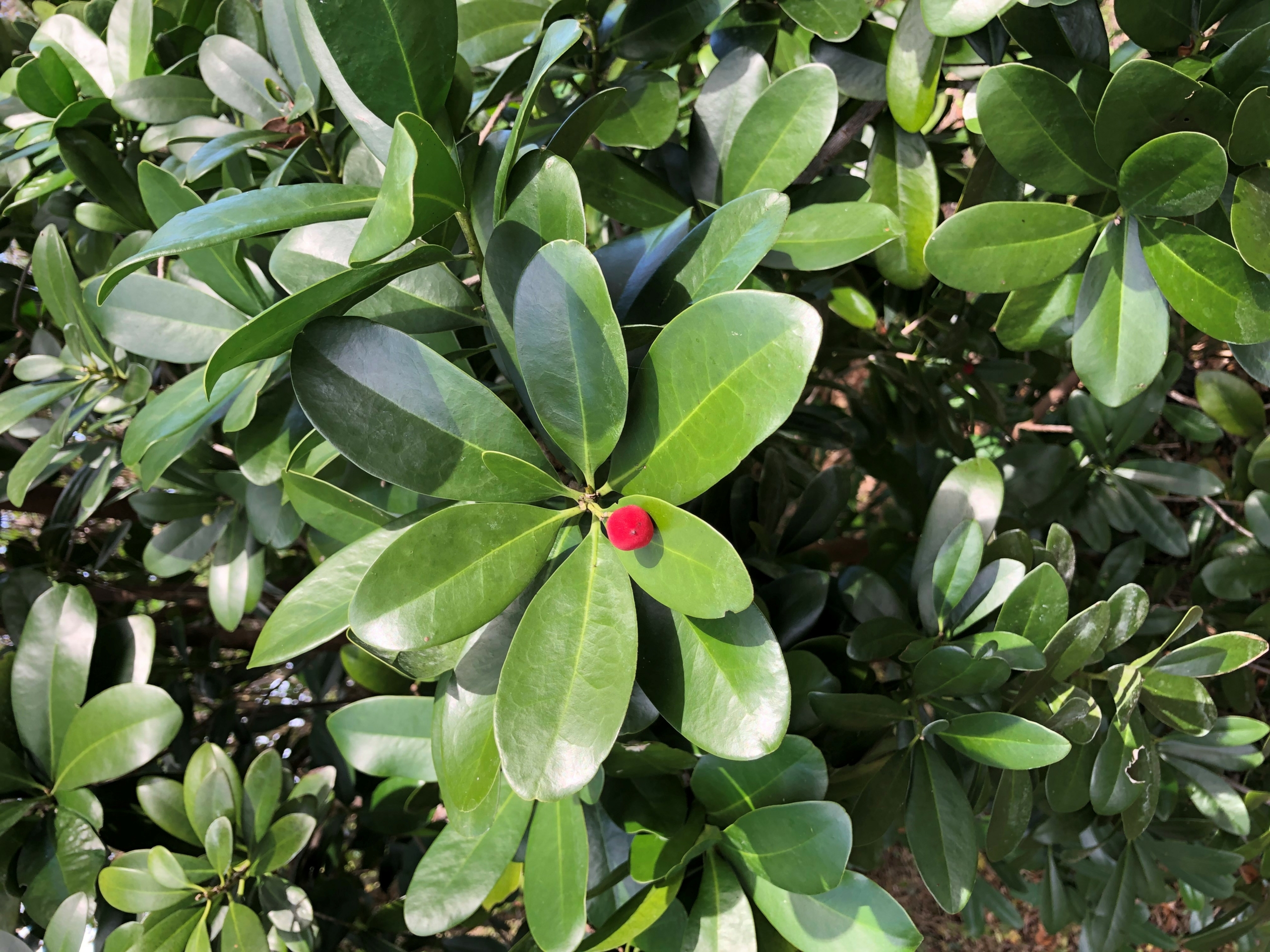
South Florida Slash Pine
Pinus elliottii var. densa
Pinus elliottii var. densa is our South Florida slash pine, distinctive from other varieties of slash pine that grow in north Florida and the rest of the southeastern United States. It grows on thin soil over limestone in pine rocklands in Miami-Dade and Monroe counties.

South Florida slash pine is a tall (to 50′) medium-fast growing tree with open branching, making it a good possible choice for a shade tree. Cones are usually produced beginning at the age of ten years. This pine must have full sun all day, excellent drainage and no disturbance to their root systems.
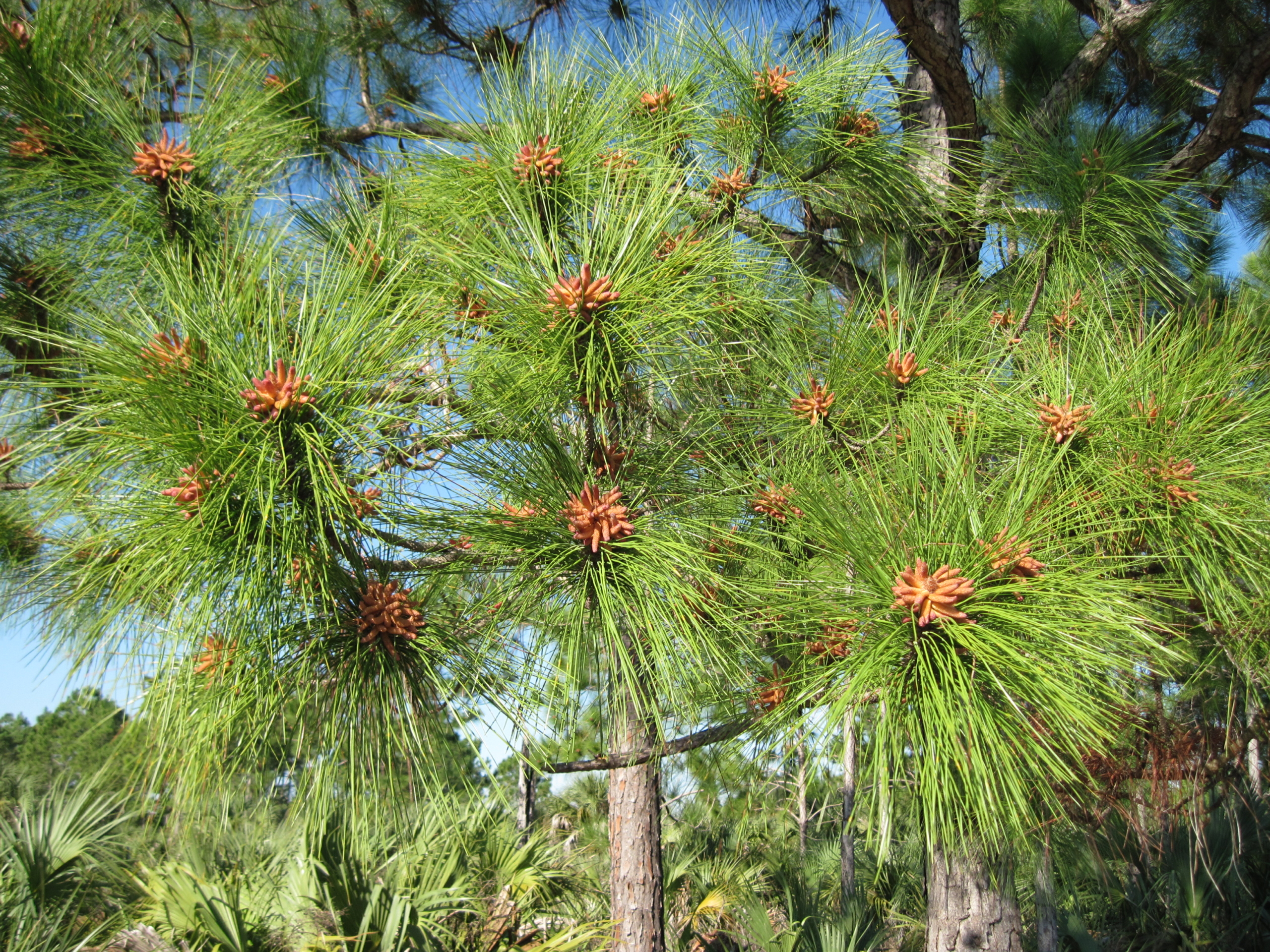
Myrtle-of-the-River
Calyptranthes zuzygium
Calyptranthes zuzygium, Myrtle-of-the-River, is native to South Florida, the Bahamas, West Indies, and Tropical America. It is a medium-sized (to 20 feet) tree. The leaves are dark yellow-green and almost stemless, opposite, tapering to a point at the apex, and have slightly wavy margins. During the summer, small, greenish-white flowers appear, followed by small fruit which turns red, then blue, and finally purplish-black. Birds are fond of the fruit of these native plants.
West Indian Cherry
Prunus myrtifolia
Prunus myrtifolia, West Indian cherry, is a slender tree 25 to 40 feet tall, with grey, roughened bark. When crushed, the dark green, elliptic to oblong-ovate leaves give off the aroma of cherry cough syrup. Small, white flowers appear in winter, followed by black fruit in the summer. West Indian cherry, native to South Florida, Central America, and the Caribbean, is typically seen in hammocks. It may be grown in full sun to light shade.
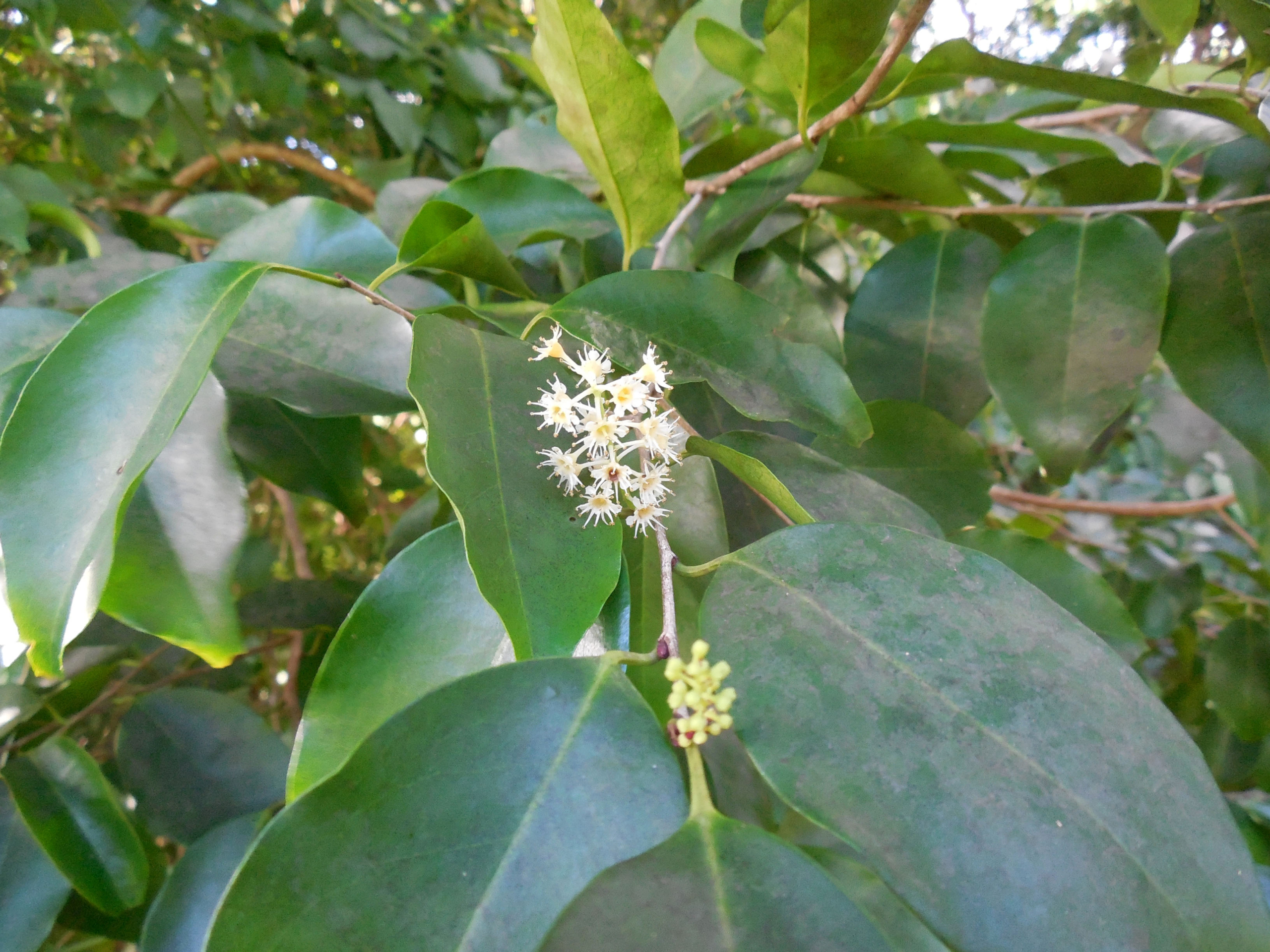
Jamaica Caper
Capparis cynophallophora
Capparis cynophallophora, Jamaica caper, is a native shrub or small tree. In the spring or early summer, it produces large quantities of flowers. The flowers have four white petals and many purple stamens, which extend beyond the petals. They look like miniature fireworks.
Fruit are slender, rust-colored pods that split open to expose seeds enclosed in an orange-red aril. The dense, strong Jamaica caper is very wind-resistant and extremely salt tolerant. It is one of our most beautiful native plants. Jamaica caper can be grown in full sun to light shade.
Spicewood
Calyptranthes pallens
Calyptranthes pallens, spicewood, is a shrub to small tree native to the coastal hammocks of Miami-Dade and Monroe Counties, and the Caribbean. The leaves, aromatic when crushed, are light green or pink when young. Small white fragrant flowers are followed by fruits which turn from red to black. When fully ripe, they are very attractive to birds. Specimens are often multi-trunked, with an open, graceful habit. Spicewood is a splendid choice for a lightly shaded location.
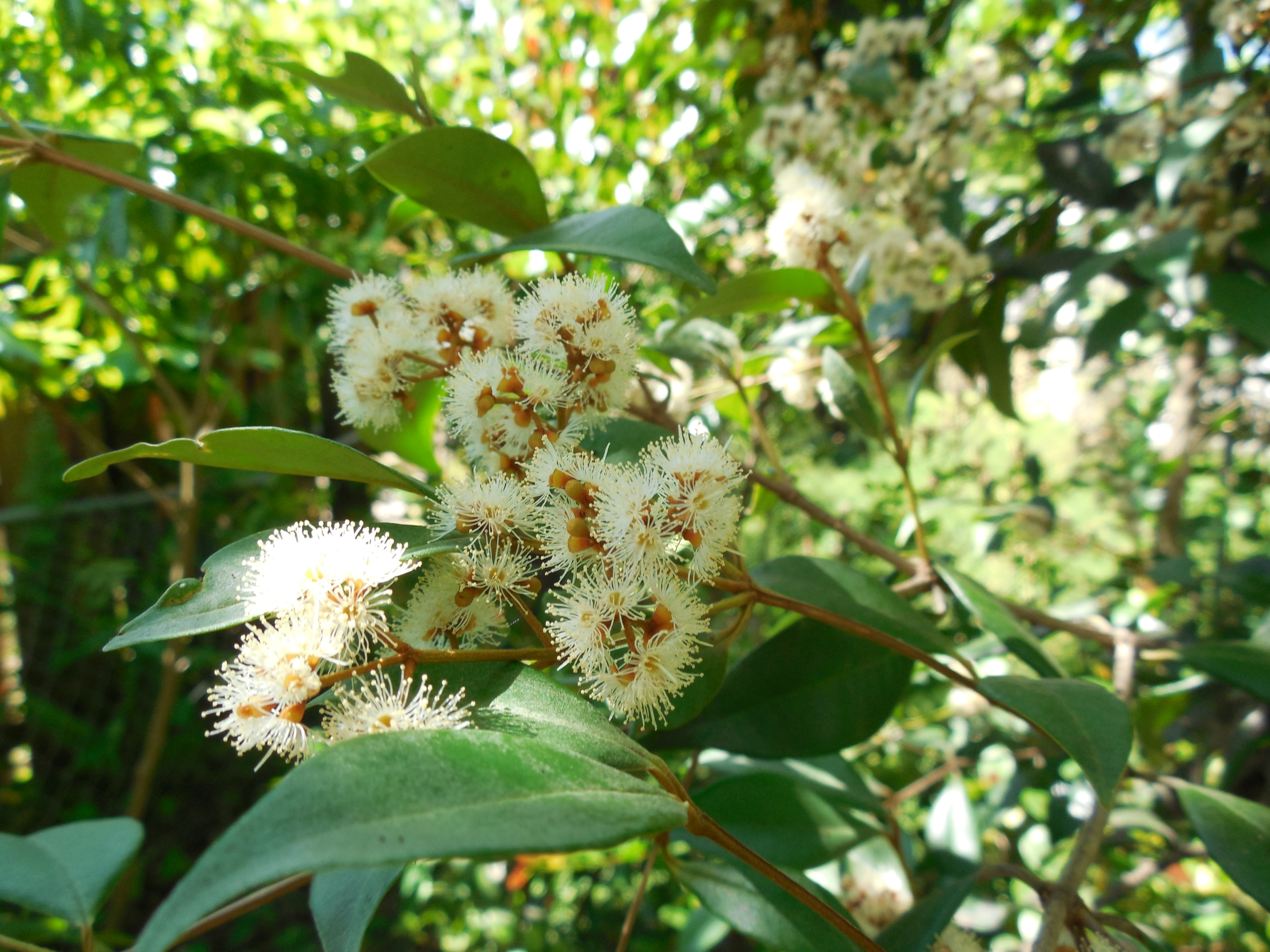
Red-Berry Stopper
Eugenia confusa
Eugenia confusa, red-berry stopper, is a small tree native to hammocks of South Florida and the Caribbean. Its shiny, dark green leaves set off the attractive pink-red new growth. In the fall, clusters of small, white flowers appear in the axils of leaves, followed by brilliant red fruits which ripen the following spring, attracting birds.
When grown in the shade, red-berry stopper forms a narrow, upright crown; in the sun, the crown will become compact and attractively rounded. The red-berry stopper, rarely available for sale, is exceptionally beautiful and enduring in the landscape.
Inkwood
Exothea paniculata
Exothea paniculata, inkwood, is a small to medium sized tree tree native to Florida with a spreading, dense crown of pinnately compound, lustrous leaves. Fragrant white flowers are produced from January to April. Female trees produce fruits which from mature red to black. Birds love the fruit. Inkwood is native to hammocks of South Florida, the West Indies, and Central America. Grow it in light shade to full sun.
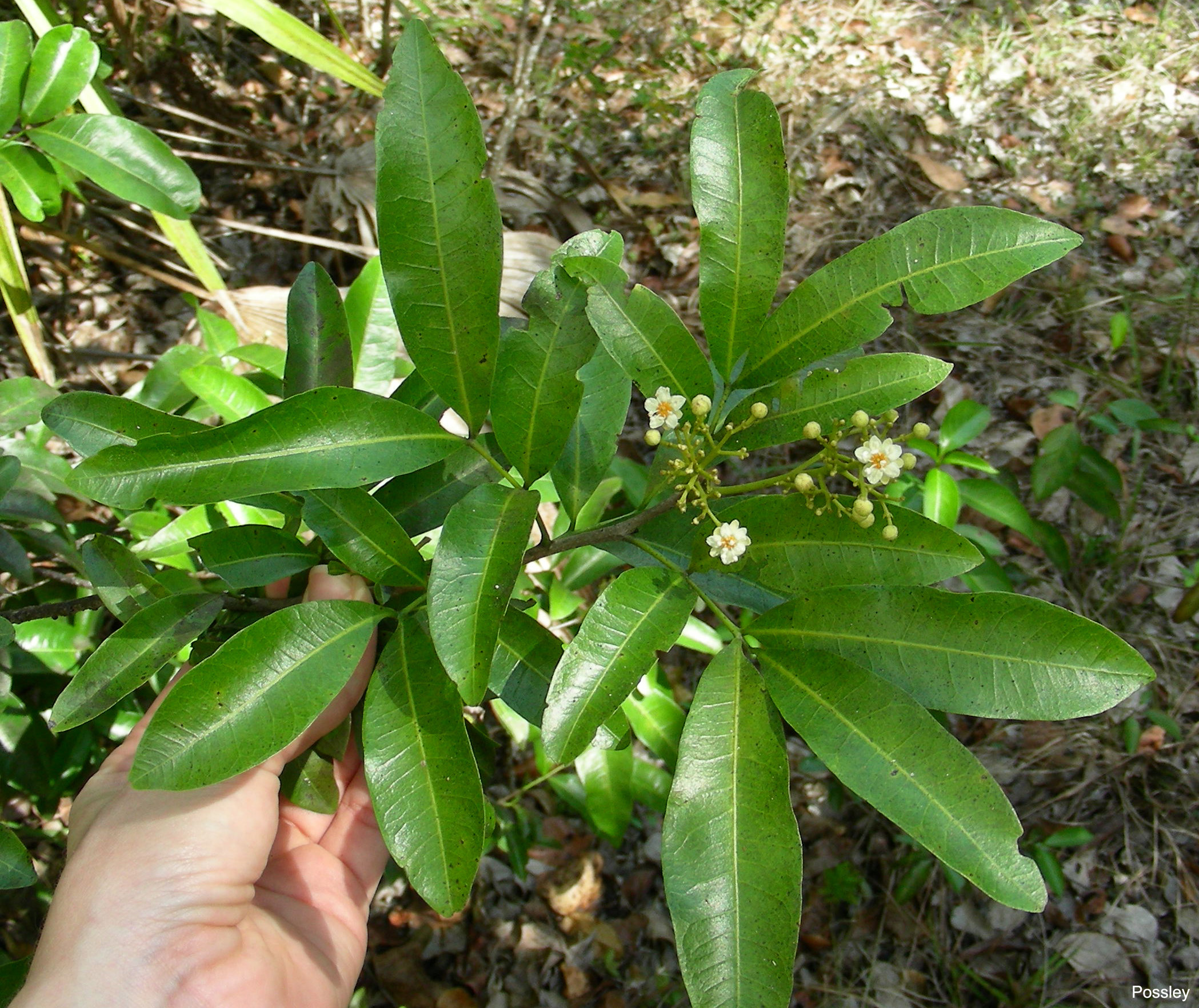
White Ironwood
Hypelate trifoliata
Hypelate trifoliata, white ironwood, is an evergreen shrub to small tree with unusual trifoliate leaves. Small, lightly fragrant white flowers open in spring to summer, and are followed by small black fruits much loved by birds. The white ironwood has a neat, upright, rather dense growth habit. It is quite rare in Florida where it grows in hammocks in the Everglades and the Florida Keys. It is also native to the Caribbean.
Darling Plum
Reynosia septentrionalis
Reynosia septentrionalis, darling plum, is an evergreen shrub to small tree, usually under ten feet tall, with a low, spreading growth habit. Native to the coastal hammocks of South Florida, the Keys, the Bahamas, and Cuba, this species is extremely salt tolerant. It has reddish bark, and tough, strong wood. Small yellow flowers appear in the spring followed by half inch black fruits. Grow these native plants in full sun to light shade.
Bahama Strongbark
Bourreria succulenta
Bourreria succulenta, known as Bahama strongbark, is a rare large shrub to small tree with spreading branches which are pendant at their tips. Very fragrant small white flowers are followed by showy orange to red fruit. The flowers are visited by Bahamian Swallowtail, Giant Swallowtail, Julia, Large Orange Sulphur, Mangrove Skipper, Southern Broken-dash Skipper and other butterflies. Hummingbirds also gather nectar from the sweet flowers.
Bahama strongbark may be grown in full sun to light shade. A wonderful plant for wildlife, this species also provides fruit for many kinds of birds.
Locustberry
Byrsonima lucida
Byrsonima lucida, locustberry, is native to pine rocklands of the South Florida landscape. The new leaves on this shrub to small tree reaching 15 feet, emerge a beautiful shade of mahogany red. Leaves provide a food source for the Florida duskywing, a rare native butterfly which has been spotted in a few Miami yards. Locustberry has clusters of colorful flowers in the spring. These flowers turn from white to pink and from pink to crimson with bright yellow stamens, making it a great choice for an ornamental plant.
Specialized oil glands beneath the flowers attract solitary oil-collecting bees. Green fruits ripen to pinkish brown. Birds love the fruit. Locustberry makes a beautiful, full shrub for a sunny to lightly shaded location. It is both drought tolerant and salt tolerant.
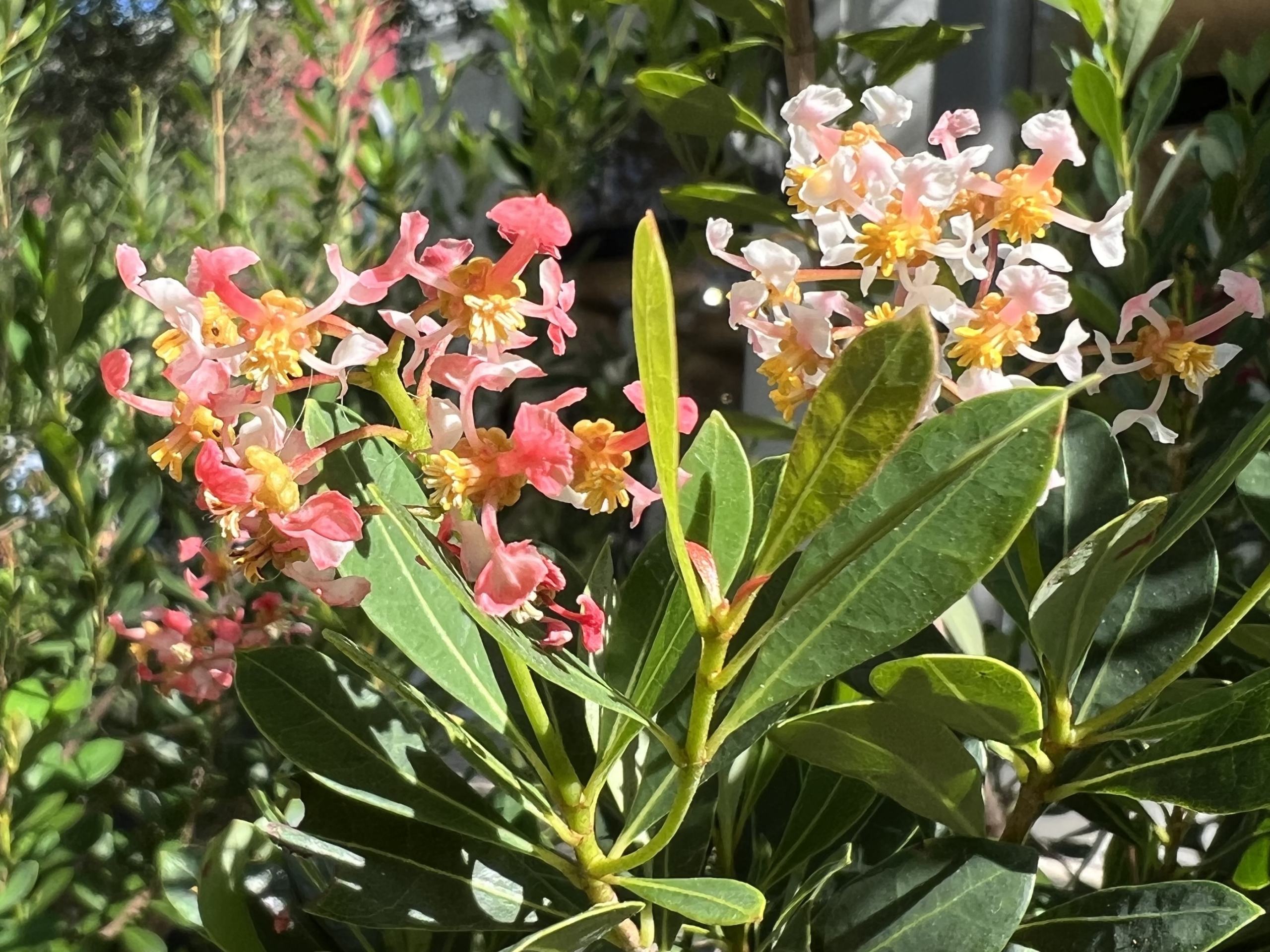
Shop the Fairchild Native Plant Nursery
Vines Native to Florida
Wild Allamanda
Pentalinon luteum
Pentalinon luteum, also known as wild allamanda, is a vine native to coastal areas of central Florida continuing south to the West Indies. The showy, trumpet-shaped yellow flowers among shiny bright green leaves appear from April to November. This beautiful vine grows best in full sun on a trellis, fence or other type of support.
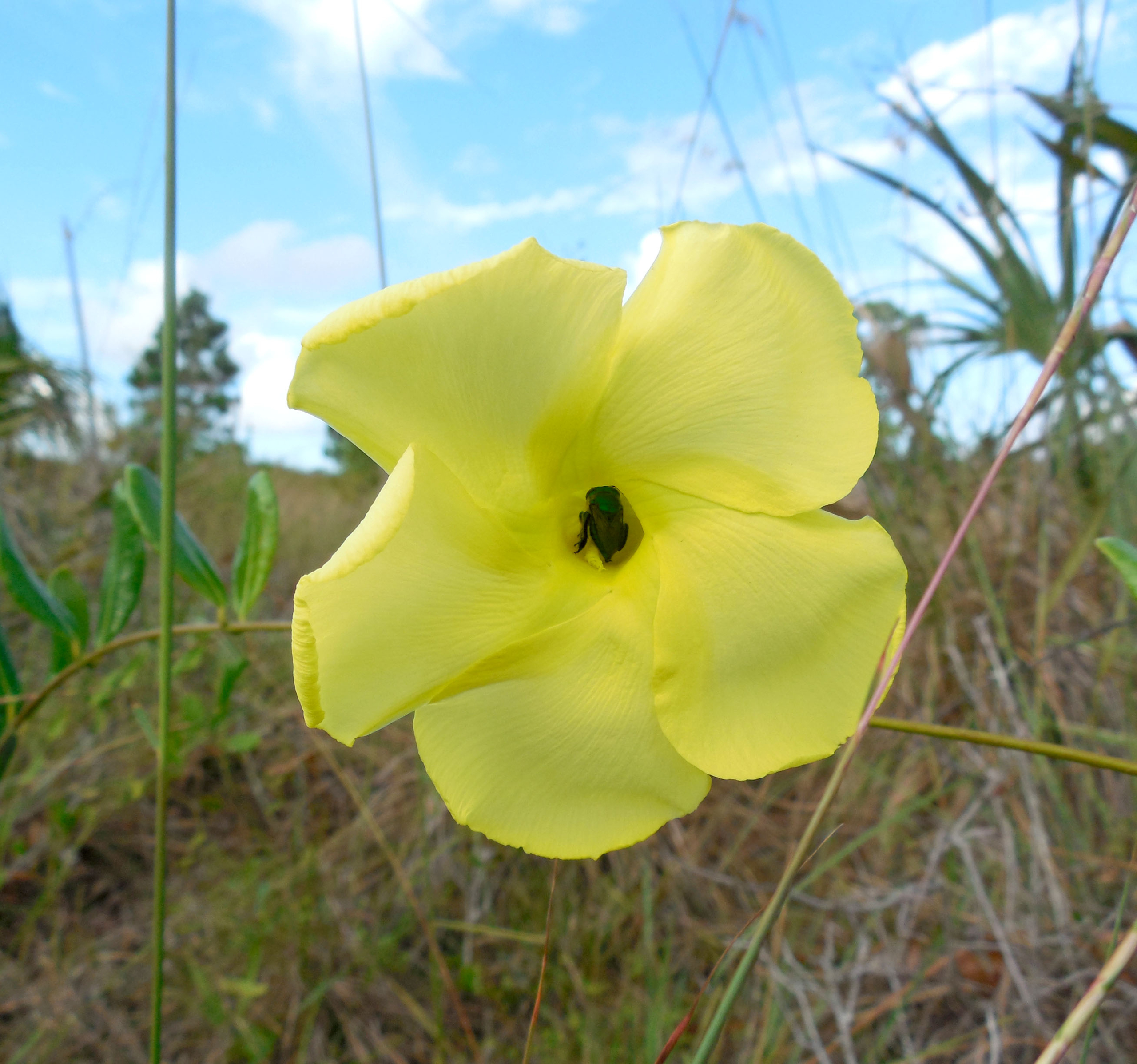
Corky-Stemmed Passionflower
Passiflora suberosa
Passiflora suberosa, corky-stemmed passionflower, is one of our best native plants for attracting butterflies to your garden. This vine may be grown as a ground cover or allowed to climb up on a low structure or shrubs. Besides being one of the more beautiful Florida native flowers, it is the larval host plant for Gulf Fritillary, Julia, and Zebra Longwing butterflies who linger around this vine, searching for new growth on which to lay their eggs. Birds will visit this vine to eat the tiny dark purple fruits. The corky-stemmed passionflower may be grown in full sun to light shade from southern to north and central Florida.
Palms Native to Florida
Silver Palm
Coccothrinax argentata
Coccothrinax argentata, known as silver palm, is small but perfectly proportioned palm native to Florida, with a 3-5 foot wide canopy of fan-shaped leaves sitting atop a smooth, slender trunk. In late summer, spikes bearing hundreds of small creamy-white flowers emerge from the canopy. Small pearl-sized fruits follow, changing from green to dark purplish black. Silver palm is a small, slow-growing palm, perfect as a specimen plant in a patio garden. It will thrive in a hot, sunny location. Salt spray is no problem either, as this plant species grows naturally along the coastline. The only thing that can kill it is too much shade and water.
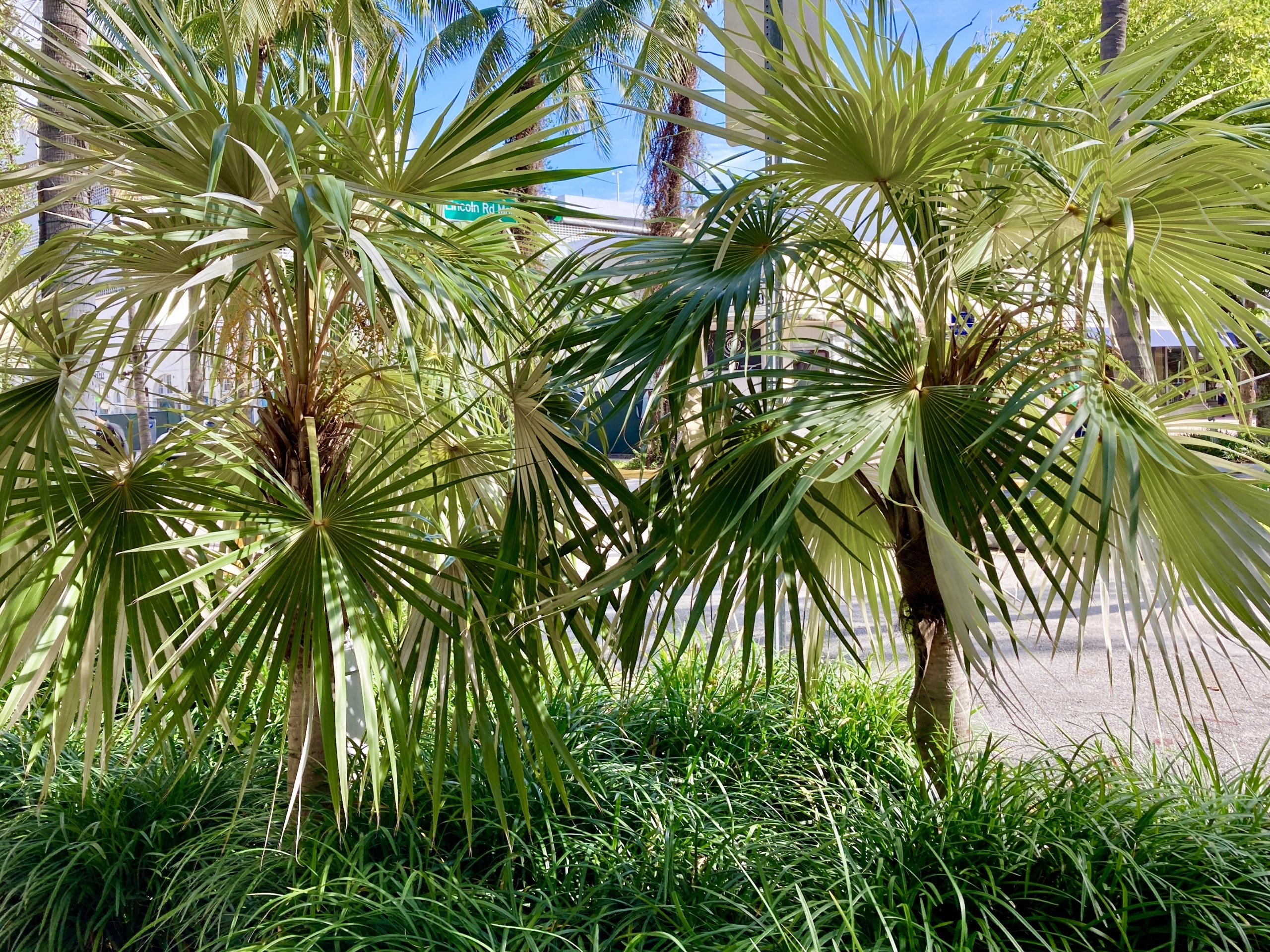
Florida Thatch Palm
Thrinax radiata
Thrinax radiata, known as Florida thatch palm, is known for its broad, deep green, palmate leaves. The natural dark, glossy green color of the leaves and contrasting clusters of white fruits make this super easy-to-grow palm a must for every native plant garden. This palm grows best in a sunny location.
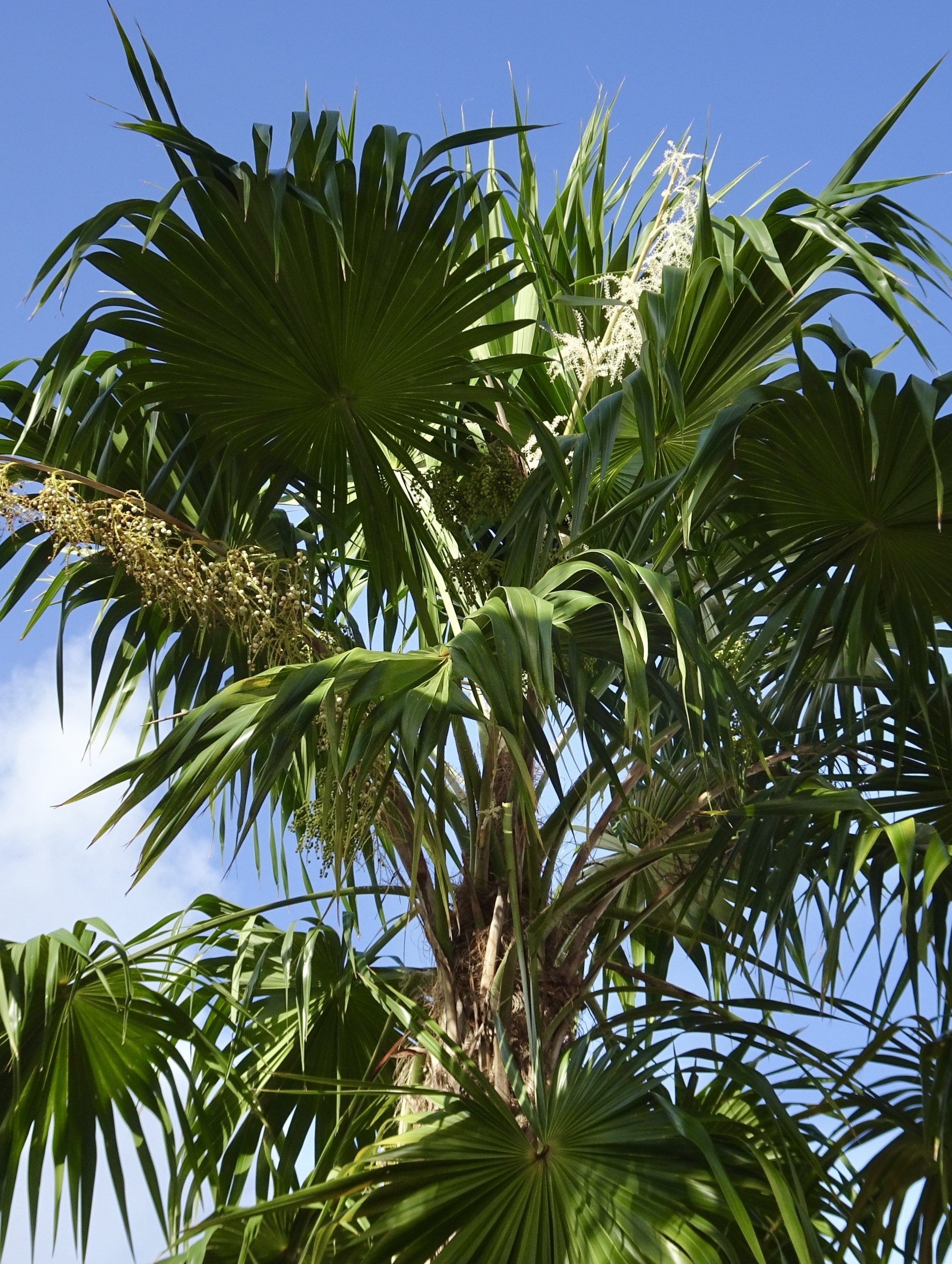
Cabbage Palm
Sabal palmetto
Sabal palmetto, the cabbage palm and our state tree, is an excellent wildlife attractor and one of our most durable native plants, with high salt, wind, and drought tolerance. This adaptable palm may be grown in full sun to light shade.

Grasses Native to Florida
Muhly Grass
Muhlenbergia capillaris
Muhlenbergia capillaris, Muhly grass, is a gorgeous grass that is native to the Southeastern US, the West Indies, Mexico and Central America. In South Florida, it is found in pine rocklands and marl prairies. Muhly grass is a fantastic yard plant. It densely fills in several square feet and has beautiful feathery pink flowers in late summer. Muhly great for wildlife; it is a potential larval host plant for several moths and butterflies. Full sun required.

About Native Plant Gardening
What are native plants, and why should you plant them? Natives are plants and trees that exist naturally in an area, or have become naturalized, without the intervention of humans. For example, most plants brought to a new area to serve as food or ornamentals are not native, so even very familiar friends like avocados and mangos are not native to Florida.
However not all non-natives are bad. We depend on many for our very survival. Some, however, are so adaptable that they excel and overtake many native plants that animals have come to depend on for their own survival. These may be considered invasive plants, and are to be avoided. Some are even illegal to plant.
By planting native Florida plants, you will support and attract our essential insects, birds and countless other animals that lay their eggs on, or consume, only native plants. There is still another benefit to native plants: they are designed by nature to grow here, so once they are established, they require little or no irrigation or fertilizer. Nature will take care of your yardwork!
There are many nurseries offering native Florida plants. Learn as much about them before you buy to make sure you are getting what you need. Fairchild’s many plant sales also offer many spectacular—and often quite hard to find—native plants for your landscape.
